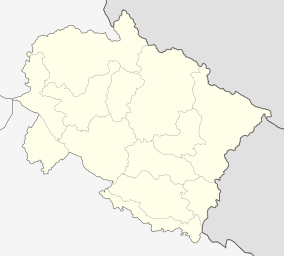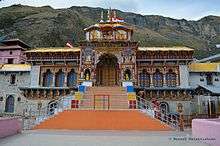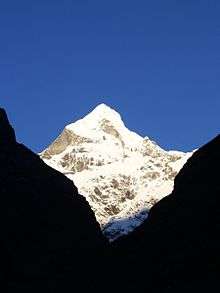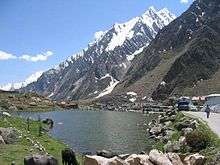Badrinath
| Badrinath | |
|---|---|
| Town | |
 Badrinath Valley, along the Alaknanda River | |
 Badrinath Location in Uttarakhand, India  Badrinath Badrinath (India) | |
| Coordinates: 30°44′38″N 79°29′35″E / 30.744°N 79.493°ECoordinates: 30°44′38″N 79°29′35″E / 30.744°N 79.493°E | |
| Country | India |
| State | Uttarakhand |
| District | Chamoli |
| Area | |
| • Total | 3 km2 (1 sq mi) |
| Elevation | 3,300 m (10,800 ft) |
| Population (2001) | |
| • Total | 841 |
| • Density | 280/km2 (730/sq mi) |
| Languages | |
| • Official | Hindi, Garhwali |
| Time zone | UTC+5:30 (IST) |
| Vehicle registration | UK 11 |
| Website |
india |
Badrinath is a holy town and a nagar panchayat in Chamoli district in the state of Uttarakhand, India. It is the most important of the four sites in India's Char Dham pilgrimage and gets its name from the temple of Badrinath.
Name
Badri refers to a berry that was apparently said to grow abundantly in the area, and nath means "Lord" / "Lord of" as per context in which it is referred. Badri is also the Sanskrit name for the Indian Jujube tree,[1] which has an edible berry. Some scriptural references refer to Jujube trees being abundant in Badrinath.
History
Badrinath was re-established as a major pilgrimage site by Adi Shankara in the 7th century.[2] In earlier days, pilgrims used to walk hundreds of miles to visit Badrinath temple.[3]
The temple has been repeatedly destroyed by earthquakes and avalanches. As late as the First World War, the town consisted only of the 20-odd huts used by the temple's staff, but the site drew thousands each year and up to 50,000 on its duodecennial festivals (every twelve years).[4] In recent years its popularity has increased still more, with an estimated 600,000 pilgrims visiting during the 2006 season,[5] compared to 90,676 in 1961.[6] The temple in Badrinath is also a sacred pilgrimage site for Vaishnavites. Badrinath is also gateway to several mountaineering expeditions headed to mountains like Nilkantha.[3]
Temple

.jpg)





The Badrinath temple is the main attraction in the town. According to legend Shankar discovered a black stone image of Lord Badrinarayan made of Saligram stone in the Alaknanda River. He originally enshrined it in a cave near the Tapt Kund hot springs.[6][7] In the sixteenth century, the King of Garhwal moved the murti to the present temple.[6] The temple is approximately 50 ft (15 m) tall with a small cupola on top, covered with a gold gilt roof.[6] The facade is built of stone, with arched windows. A broad stairway leads up to a tall arched gateway, which is the main entrance. The architecture resembles a Buddhist vihara (temple), with the brightly painted facade also more typical of Buddhist temples.[8] Just inside is the mandapa, a large pillared hall that leads to the garbha grha, or main shrine area. The walls and pillars of the mandapa are covered with intricate carving.[8]
Legend
According to the Bhagavata Purana, "There in Badrikashram the supreme being (Vishnu), in his incarnation as the sages Nara and Narayana, had been undergoing great penance since time immemorial for the welfare of all living entities." (Bhagavata Purana 3.4.22)
The Badrinath area is referred to as Badari or Badarikaashram (बदरिकाश्रम) in Hindu scriptures. It is a place sacred to Vishnu, particularly in Vishnu's dual form of Nara-Narayana. Thus, in the Mahabharata, Krishna, addressing Arjuna, says, "Thou wast Nara in a former body, and, with Narayana for thy companion, didst perform dreadful austerity at Badari for many myriads of years."[9][10]
One legend has it that when the goddess Ganga was requested to descend to earth to help suffering humanity on the request of suryavansh king bhagiratha, the earth was unable to withstand the force of her descent. Therefore, the mighty Ganga (Ganges) was split into two holy channels, with Alaknanda one of them.
Another Legend explains both name and sitting posture as this place was full of Badri bushes and Vishnu meditating for, beloved Lakshmi stood next to him sheltering him from scorching sunlight turned into a Badri herself called 'BADRI VISHAL' and her lord(Nath) became the BadriNath.
The mountains around Badrinath are mentioned in the Mahabharata, when the Pandavas were said to have expired one by one, when ascending the slopes of a peak in western Garhwal called Swargarohini.(literal meaning - the 'Ascent to Heaven'). The Pandavas passed through Badrinath and the town of Mana, 4 km north of Badrinath, on their way to Svarga (heaven). There is also a cave in Mana where Vyasa, according to legend, wrote the Mahabharata.[6]
The area around Badrinath was celebrated in Padma Purana as abounding in spiritual treasures.
This place is considered holy in Jainism as well. In Jainism, Himalaya is also called Ashtapad because of its eight different mountain range Gaurishankar, Kailash, Badrinath, Nanda, Drongiri, Narayan, Nar and Trishuli. Adinath (Rishabhdev and Vrishabhdev are his another names) has got Nirvan on Kailash mountain situated in the Himalayan range and according to Jain faith (Nirvankand), From badrinath numerous jain Muni got Moksha by doing Tapsya. According to Shrimadbhagwat, at this place Rishabhdev’s father Nabhirai and mother Marudevi had done hard Tap after Rishabhdev’s Rajyabhishek and taken Samadhi. Even today footprint of Nabhirai at Neelkanth mountain attracts everybody towards him. [6]
Geography
Badrinath has an average elevation of 3,100 metres (10,170 feet). It is in the Garhwal Himalayas, on the banks of the Alaknanda River. The town lies between the Nar and Narayana mountain ranges 9 km east of Nilkantha peak (6,596m). Badrinath is located 62 km northwest of Nanda Devi peak and 301 km north of Rishikesh. From Gaurikund (near Kedarnath) to Badrinath by road is 233 km.
Demographics
As of 2001 India census,[11] Badrinath had a population of 841. Males constitute 55% of the population and females 45%. Badrinath has an average literacy rate of 89%, ; with 92% of the males and 86% of females literate. 9% of the population is under 6 years of age.
See also
Notes
- ↑ "Ziziphus mauritiana - Ber". flowersofindia.net.
- ↑ "Badrinath". Archived from the original on 2012-06-15.
- 1 2 Wylie, C.G. "Himalayan journal : A PRE-SWISS ATTEMPT ON NILKANTA(1947)". The Himalayan Club. Retrieved 6 June 2013.
- ↑ EB (1911).
- ↑ The Hindu newspaper, 17 November 2006
- 1 2 3 4 5 6 Nautiyal, Govind Prasad, Call of Badrinath, Shri Badrinath-Kedarnath Temples Committee, 1962.
- ↑ Randhir Prakashan, The Holy Places of Uttarakhand Yatra.
- 1 2 Sen Gupta, Subhadra, Badrinath and Kedarnath - The Dhaams in the Himalayas, 2002. ISBN 81-7167-617-0
- ↑ Dowson's Classical Dictionary of Hindu mythology
- ↑ Gopal, Madan (1990). K.S. Gautam, ed. India through the ages. Publication Division, Ministry of Information and Broadcasting, Government of India. p. 75.
- ↑ "Census of India 2001: Data from the 2001 Census, including cities, villages and towns (Provisional)". Census Commission of India. Archived from the original on 2004-06-16. Retrieved 2008-11-01.
References


External links
| Wikimedia Commons has media related to Badrinath. |
- Official website of Shri Badarinath - Shri Kedarnath
